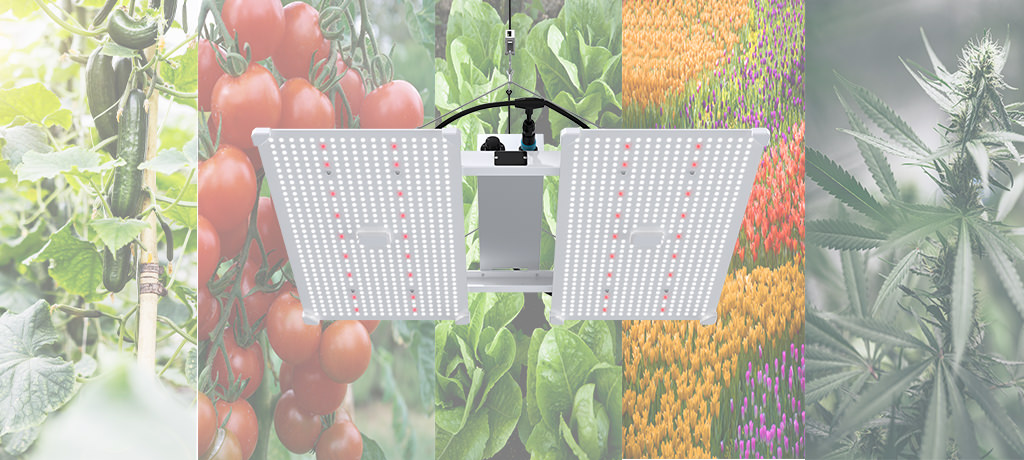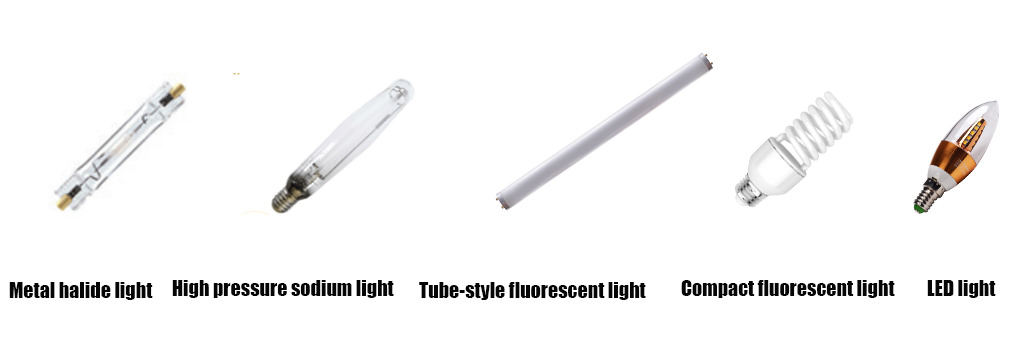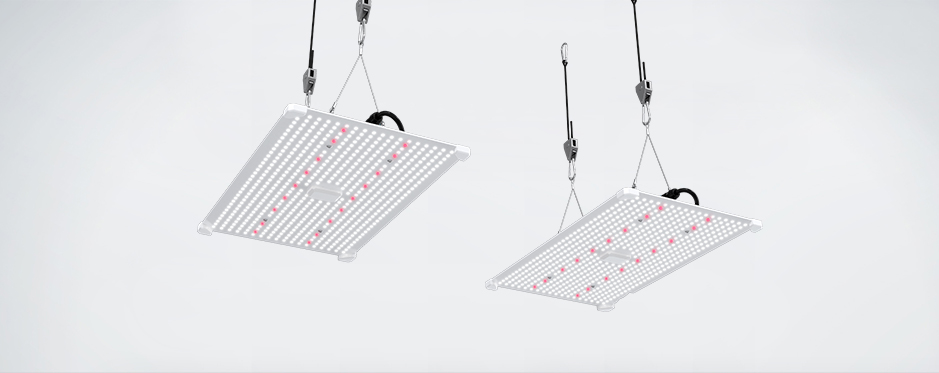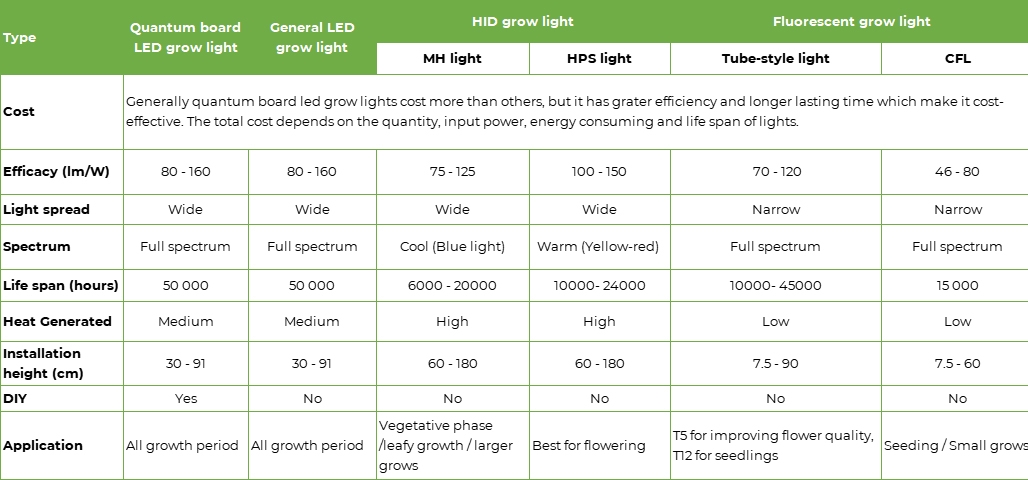Quantum Board LED Grow Light vs Other Types of Grow Lights

Grow lights can simulate or completely replace the sunlight that plants need, providing the right amount of light for plants to promote growth and improve yield and quality. Grow lights are ideal for indoor or the places lack of sunlight to help plants grow. The lighting enable year-round production in colder territories, getting plants to market early. Farmers would have the harvest forward and earn more. But each type of plants requires lighting quality in diverse intensity, spectrum, color temperature, etc. What’s more, there are so many types of grow lights with varied specifications, which may makes you scratch your head during selection.
Quantum board LED grow light is one of the newest type lights in the plants lighting market. What quantum board LED light is? What are the differences between the various grow lights?To clarify the question, let’ s talk about the comparison of them.
Grow lights classification
HID grow lights
HID (high-intensity discharge) grow light is one of the most widely used grow lights in market thanks to its highest lumen-per-watt efficiency. But it also cost more than other grow lights as the high price. HID grow light mainly divided into MH light and HPS light. As the limited of them, most advanced growers use a combination of MH and HPS bulbs for the duration of the process.
MH lights
MH (metal halide) lights produce a “cooler” and blue and white light, which is conducive to the growth of leaves and keeping plants compact. The color temperature is about 5500k. MH lights are best to be used as the main light source for plants. Generally, a single bulb can lasting about 10,000 hours. It doesn't mean the lights are out of service exceed 10,000 hours, but the lighting output would reduced. MH lights can produce up to 125 lumens per watt. Compared to 39 lumens per watt for standard fluorescent lamps and 18 lumens per watt for standard incandescent bulbs, MH lights are of high efficiency.
HPS lights
HPS (high pressure sodium) lights produce red or orange light. This makes HPS lights being better for flowering. It is economical because it lasts twice as long as MH light. HPS lights produce up to 140 lumens per watt. But the lighting efficiency will decline sharply and consumption increased after long time usage. Their main drawback is that they do not produce light within the blue spectrum. If HPS lights are used as the only lighting source for plants, the plants will grow in a long and thin shape, which can not meet the growers’ requirement.
Fluorescent grow lights
Fluorescent grow lights are a good and cheap option as a start of grow lights.Fluorescent grow lights generate less heat than HID lights, so they won’t burn your plants. You can placed they near the plants without fear to promote plants absorbing and using the light. The color temperature of fluorescent grow lights range from 2,700k to 10,000k. The scope of luminous efficacy is 30 lm/W to 90 lm/W. Tube-style fluorescent lights (T5, T8, T12) and compact fluorescent lights (CFL) are two major types of fluorescent grow lights.
Tube-style fluorescent grow lights
T5 is the brightness vision and it can be applied to flower bud differentiation and improve flower quality. T12 is ideal for starting seedlings to get a jump start on spring plantings.
Compact fluorescent grow lights
As most of fluorescent lights are of large size and heavy weight, compact fluorescent lights are designed with smaller versions. Compact fluorescent lights are especially suited to small grows that looking for supplemental light.
LED grow lights
LED grow lights consist of light emitting diodes, usually fixed in a housing with a heat sink or built-in fan. LED grow lights usually do not require a separate ballast and can be plugged directly into a standard power outlet for using.
The green, red, far-red and blue light spectra have an effect on root formation, plant growth and flowering, but there are not enough scientific studies or field tests to test the specific color ratios recommended for grow lights. It has been shown that many plants will grow normally if given red and blue light. However, many studies have shown that red and blue light only provide the most cost-effective method of growth and that plants grow better under supplement with green light.
White LED grow lights offer a full spectrum to mimic natural light, providing plants with a balanced spectrum of red, blue and green. While white LED grow lights are designed to emit similar amounts of red and blue light, with the added green light appearing as white. White LED grow lights are commonly used for supplemental lighting in homes and office spaces.
Just a few years ago, LEDs were not suitable for “serious” grows, aside from providing light for seedlings or clones. However, LED technology has come a long way in a short time. Today, with the development of LED light, it can rival, or even surpass other types of grow lighting. But we should also notice that LED grow light may “burn” the light as the high output, thus, we have better keep proper distance from lights to plants.
Quantum board LED grow lights
The quantum board LED growth light sounds strange to most people. It is one of the LED lights. Quantum board LED grow light refers to a new style of lighting in which a large number of small LED diodes are attached to a flat panel. These diodes are arranged in rows and run in a parallel configuration by a high-power constant current driver. But the diodes are open and exposed and, in many cases, so are the wires. A few of the manufacturers have recently begun adding plastic covers over the exposed wires, but many still have the wires open. All of this means the components are less protected. But it does keep costs down.
Quantum board LED grow lights increase the yield as less power, so it have become popular options. It can provide light efficacy of 2.7 umol/J. It also emits a full spectrum white light that contains every visible wavelength of light to help plants grow better. Not like the HID grow lights, quantum board LED grow lights can offer both red and blue light. Moreover, you can DIY your own quantum board LED grow light if you want.

Difference of different grow lights
Cost
When it comes to the cost of grow lights, we should consider both of the price of grow lights and the energy cost. Generally, quantum board grow lights are more expensive than others. But they also offer higher input power and longer lasting time.Though fluorescent grow lights are cheaper and of less heat, they can only provide lower lumens. It is hard to cultivate which is the most cost-effective as the price and energy cost are varied with the input power and quantity of them. Besides, the life span should be considered as well.
Efficacy
The efficacy of MH grow light is about 75 to 125 lm/W, and 100 to 150 lm/W for HPS grow lights. Fluorescent grow lights have the efficacy about 70 to 120 lm/W, while compact fluorescent grow lights having a lower efficacy about 46 to 80 lm/W. The efficacy of general LED grow lights ranges from 80 to 160 lm/W. Another measure of luminous efficiency is the number of effective photons emitted per watt per second (umol/w/s). HPS grow lights can provide 148 umol/s in 100W. It ranks the highest efficacy. For LED lights, it is hard to evaluate as there is a huge difference on various color combinations.
Light spread
There is no doubt that quantum board LED grow lights have the wider light spread than others. The light emanates from many points on the large panel and has a more direct path to the canopy outside the coverage area than light from smaller fixtures that must be emitted outward. This results in a lower intensity in the middle of the coverage area and a higher intensity around the outside. In other words: more uniform light spread.
Spectrum
The light spectra range of wavelengths that benefit to plants is visible by humans. MH lights produce a “cooler” and blue and white light. HPS lights produce red or orange light with the lack of blue spectrum. Fluorescent grow light produce both red and blue light to help plants grow better. LED grow lights emit full-spectrum white light, including every visible wavelength. They have the light close to natural sunlight to offer excellent spectrum for plants.
Although blue and red LEDs were common in the past, the industry has gradually realized that white LEDs are better for plants, so more and more manufacturers are turning to white. The advantage of quantum boards led grow lights is that they usually mix additional diodes in white diodes, offering full spectrum and customize spectrum for different plants to meet their needs in every growing period.
Life span
MH grow lights can lasting about 6,000 to 20,000 hours, while HPS grow lights can lasting about 10,000 to 24,000 hours. The life span of fluorescent grow lights is about 15, 000 to 45, 000 hours. LED grow lights can lasting up to 50, 000 hours. As quantum board grow lights are made of LED, their life span is up to 50,000 hours as well. In conclusion, LED light own the longest life span.
Heat Generated
HPS lights and MH lights emit a lot of heat, which can cause leggier growth, therefore, they need special air-cooled bulb reflectors or enclosure to control the temperature. Fluorescent light generate less heat than HID lights. LED lights produce less heat than both HID lights and fluorescent lights. Brightness and longevity increase typically with the decrease of heat output. Quantum board lights are generally mounted to a to a thin piece of aluminum (or a heat sink), which suffices to passively cool the diodes. No fans are needed.
Installation height
HID grow lights should be placed at least 60 cm away from plants for lower wattage lights (less than 250W) and 120 cm away from plants for higher wattage lights (1000W or more). Fluorescent grow lights should be placed about 7.5 cm away from plants for lower wattage lights (less than 40W) and at least 15 cm away from plants for higher wattage lights (100W or more). LED grow lights should be kept 30 cm away from plants for lower wattage lights (less than 300W) and 91 cm away from plants for higher wattage lights (1000W or more) to prevent leaf burn.
Conclusion
Here is the table of the comparison of different between quantum board led lights and other type of grow lights.

